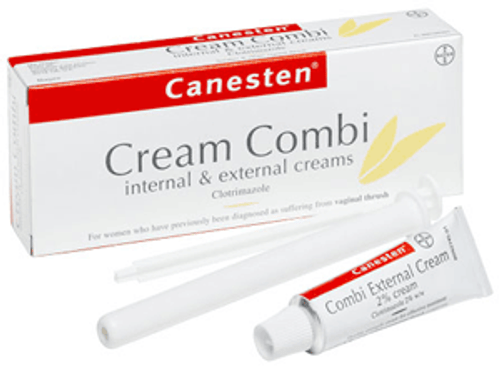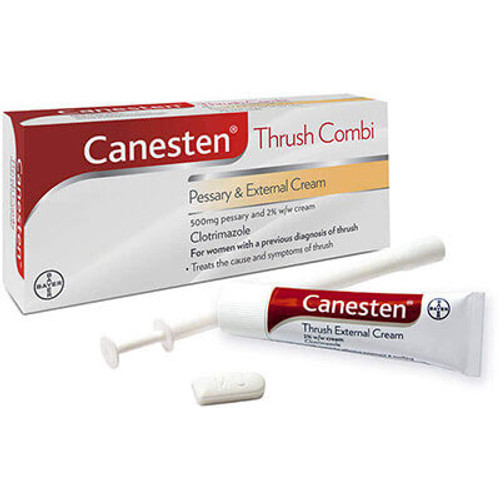The internal cream is recommended for the treatment of candidal vaginitis.
The external cream is recommended for the treatment of candidal vulvitis. It should be used as an adjunct to treatment of candidal vaginitis.
These products should only be used if candidal vulvovaginitis (thrush) was previously diagnosed by a doctor.
Adults
The internal cream should be administered intravaginally using the applicator supplied. The contents of the filled applicator (5g) should be inserted as deeply as possible into the vagina, preferably at night.
The external cream should be thinly applied to the vulva and surrounding area, two or three times daily and rubbed in gently.
Treatment with the external cream should be continued until symptoms of the infection disappear. However, if after concomitant treatment of the vaginitis, the symptoms do not improve within seven days, the patient should consult a physician.
Generally:
Treatment during the menstrual period should be avoided due to the risk of the cream being washed out by the menstrual flow. The treatment should be finished before the onset of menstruation.
Do not use tampons, intravaginal douches, spermicides or other vaginal products while using this product.
Vaginal intercourse should be avoided in case of vaginal infection and while using this product because the partner could become infected.
Children
Not for use in children under 16.
Contraindications
Hypersensitivity to clotrimazole and any of the other excipients listed in section 6.1.
Do not use to treat nail or scalp infections.
Special warnings and precautions for use
These products contain cetostearyl alcohol, which may cause local skin reactions (e.g. contact dermatitis).
Before using Canesten Thrush Combi Internal & External Creams medical advice must be sought if any of the following are applicable: -
- more than two infections of candidal vaginitis in the last 6 months
- previous history of a sexually transmitted disease or exposure to partner with sexually transmitted disease
- pregnancy or suspected pregnancy
- aged under 16 or over 60 years
- known hypersensitivity to imidazoles or other vaginal antifungal products
The creams should not be used if the patient has any of the following symptoms whereupon medical advice should be sought: -
- irregular vaginal bleeding
- abnormal vaginal bleeding or a blood-stained discharge
- vulval or vaginal ulcers, blisters or sores
- lower abdominal pain or dysuria
- any adverse events such as redness, irritation or swelling associated with the treatment
- fever or chills
- nausea or vomiting
- diarrhoea
- foul smelling vaginal discharge
If no improvement in symptoms is seen after 7 days the patient should consult their doctor.
Shipping charges mainland GB zone1
| Value | Weight | Delivery Charge |
| Over £49.00 | Any Weight | FREE |
| Under £49.00 | No weight limit | £4.50 |
| Under £49.00 | Under 250 grams | £3.49 |
Most orders are despatched the same day and standard delivery is 3 to 5 working days from despatch. FAST Expedited options are available at extra cost - these usually arrive in 24-48hrs from dispatch but delays are possible during busy periods.
Postcodes outside of Zone 1 (including some areas within mainland UK) may incur extra carriage charges due to surcharges imposed by the couriers. These will be calculated on the website at the checkout.
NB: Orders placed with faster delivery must be placed before 13:00 to ensure same day dispatch (excluding weekends and bank holidays). Please also check on the product page that the items ordered show 'In Stock' otherwise your order will be delayed until the stock becomes available, which in most cases will only be 24hrs.
Estimated "Usually shipped in" information is shown against most products
Overseas orders
We no longer send goods outside of the UK.
Prescription Items
Prescription items will be sent on receipt of a valid signed and dated prescription.
Pick up
We offer a pickup service for orders placed over the phone.
Please ring us on 01833 641112 for more information.
Refrigerated Items
Refrigerated items will be sent by carrier or express delivery at a cost of £7.50, with coolpacks, unless you pay for a premium for a refrigerated delivery. We will contact you prior to despatch for your instructions.
We want you to be completely satisfied with any purchase. If not any item* can be returned to us within 14 days of receipt for exchange or refund Please give us a ring for a returns number on 01833 641112 or alternatively email sales@hyperdrug.co.uk to obtain a returns number.
*Due to legal requirements medicines may not be returned except to correct an error in despatch or in response to an "official recall". If an item is believed to be faulty it should be returned for inspection and it may be necessary to forward it to the manufacturers for testing before replacements or refunds can be authorised. This does not infringe legal rights. Please contact our customer services for a "Returns Number" which must appear on the outside of the package or it will not be accepted. We advise customers to use an insured method of shipping and to retain proof of despatch. We may refuse returns on products specially obtained or manufactured to order. Items must be returned unsoiled and unused and sent adequately packed and carriage paid.








